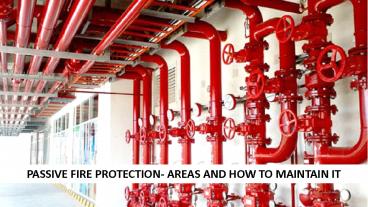Passive Fire Protection- Areas And How To Maintain It - PowerPoint PPT Presentation
Title:
Passive Fire Protection- Areas And How To Maintain It
Description:
If the worst happens and a fire breaks out in your building, your due diligence will pay off when the fire is contained - people will have time to evacuate, and you will be back in business much sooner than if no protection was in place. Passive fire protection gives you time to evacuate. – PowerPoint PPT presentation
Number of Views:360
Title: Passive Fire Protection- Areas And How To Maintain It
1
PASSIVE FIRE PROTECTION- AREAS AND HOW TO
MAINTAIN IT
2
Structural Fire protection Structural passive
fire protection guards essential structural
components (such as structural steel and joint
systems) from the effects of fire. This is
accomplished with a fireproofing material
(spray-on thin-film intumescent, endothermic
materials like gypsum-based plasters and
cementitious products, mineral wool wraps and
insulation, and fireproofing cladding) or
building the structure out of concrete products.
3
Compartmentation Fire barriers, firewalls, fire
partitions, and smoke barriers are all included
in compartmentation. Fire barriers include
fire-rated walls, floors, and ceilings (often
made of concrete, combination wood, gypsum, or
masonry). These barriers are used to limit the
spread of fire in a building.
4
Opening protection Fire doors and windows are
installed in an opening of a fire barrier to
maintain its fire resistance. Doors, builders
hardware, and frames work together to form an
effective smoke and fire barrier. Fire-rated
glazing/glass and framing are tested as a
complete assembly that maintains the protection
of the fire barrier.
5
Firestopping materials These materials are used
to limit fire spread through penetrations in a
fire barrier. Its not uncommon to see a fire
barrier penetrated during a minor building
alteration, and then the penetrating item isn't
protected by firestopping.
6
Cable Coating Other areas include cable coating
(the application of fire retardants to wire and
cable), joint systems (which include changes in
direction between fire-separating elements and
the spaces surrounded by those elements), and
perimeter fire barriers (which deal with the
perimeter of the floor and the exterior
curtainwall).
7
Maintaining Passive Fire Protection With knowing
the codes and ratings associated with each
passive fire protection system in your building,
constant and thorough maintenance is also
important. Building owners and facility managers
are important stakeholders in a buildings
fire-protection program
8
Thank You
To know more visit https//bmfire.ie/

